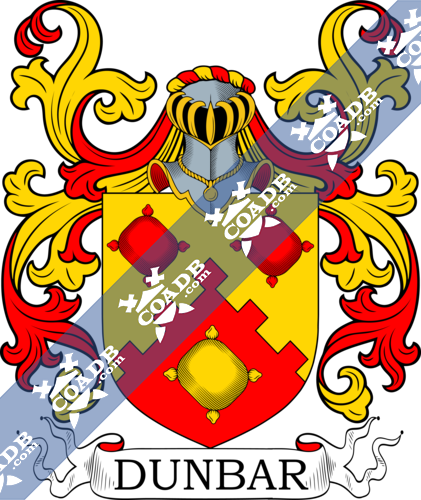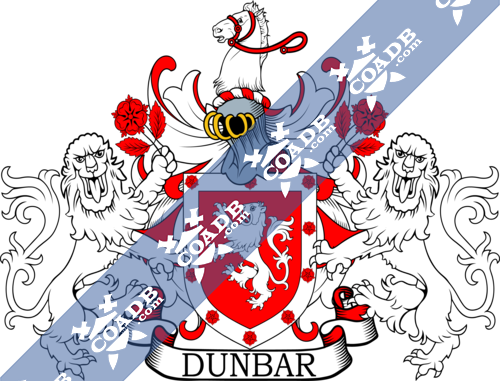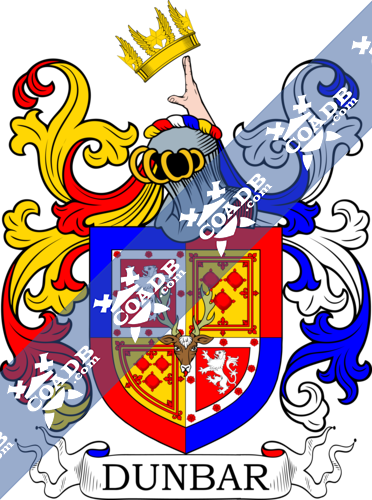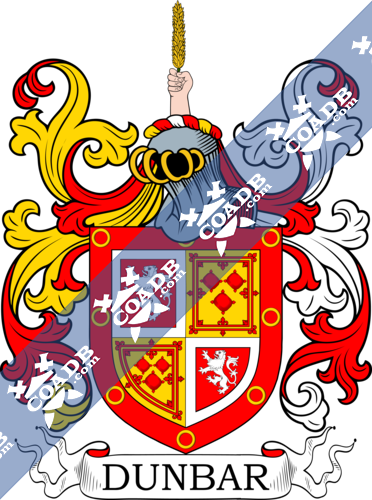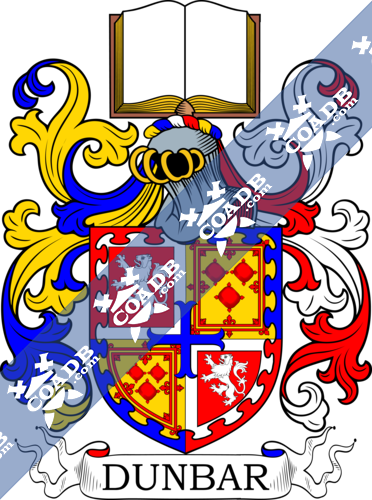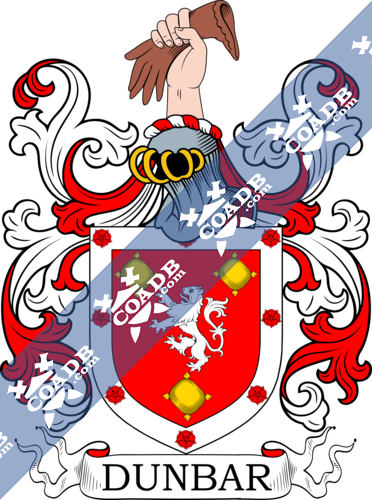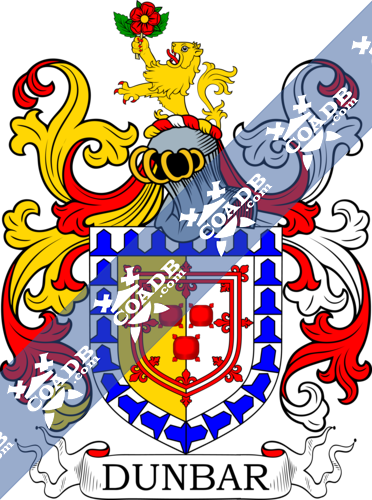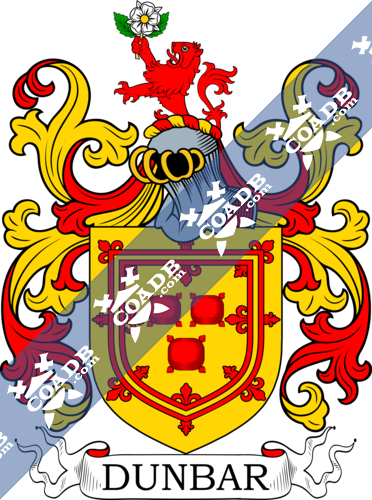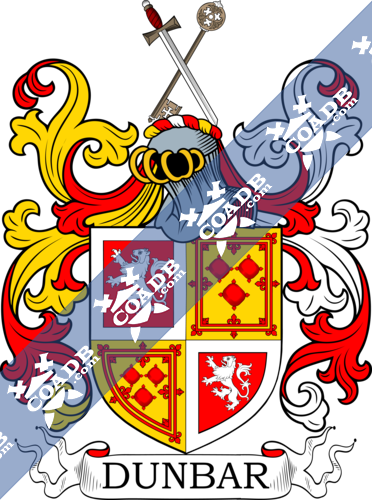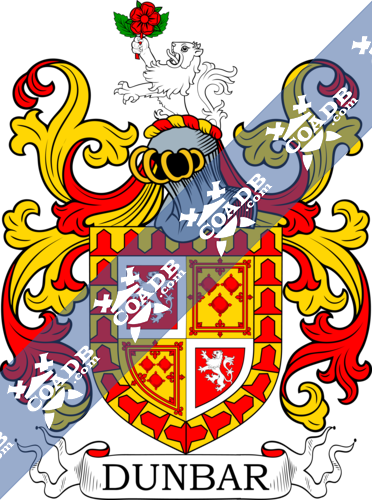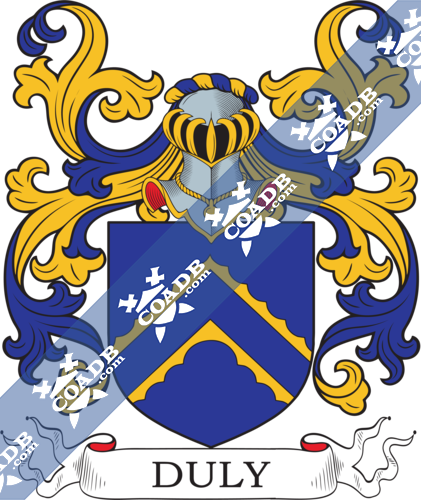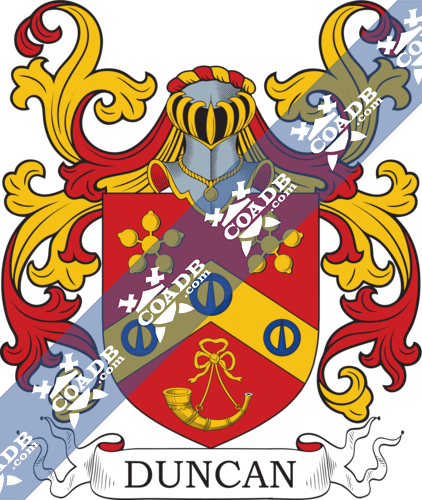Dunbar Family Crest, Coat of Arms and Name History
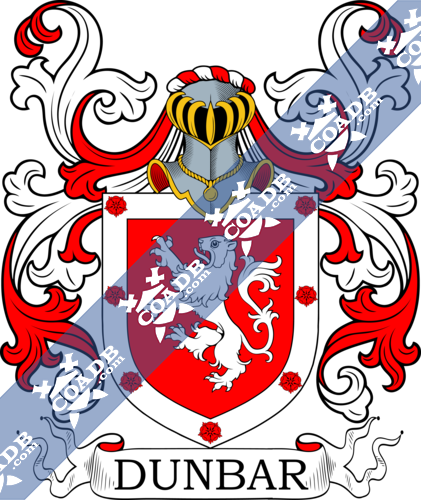
Dunbar Coat of Arms Gallery
Don’t know which Coat of Arms is yours?
We can do a genealogical research. Find out the exact history of your family!
Learn MoreDunbar
Dunbar is from the Gaelic or native Scottish language, it is made up of two parts. Dun meaning fortification or castle and Bar meaning meaning top of, or summit. A close approximation of the name would then mean Castletop. It is also the name of a Scottish Barony located in Berwick County, dating back to the 13th century.
Dunbar family or Clan, is not a highland clan, long associated with Scottish tradition as seen today. They are a lowland clan occupying the border region with England. Because of their unique geographical location, the Clan Dunbar became one of the more powerful political forces in the Kingdom of Scotland. Records indicate those bearing the name Dunbar, and or Dunbarr or one its variations are the descendants of Crinan of Dunkeld. He is listed in the historical rolls as the Earl of Northumberland, and a descendant of King Duncan of Scotland, and the Earls of Gothpatrick, who would eventually become known as the Earls of March.
Because of their prominence the Earls of Dunbar and March (a march is a borderland) they controlled Lothian, and the border communities of Roxburg, Selkirk, Peebles and Berwick. With the marriage of Patrick V to Agnes Randolph, (known to history as Black Agnes for her defense of Dunbar Castle,) her dowry included the Earldom of Morray, with control over Aberdeenshire, Morayshire, Nairn, Buchen and Inverness and the Isle of Man.
One of the most notable Earls of March, Patrick V claimed the Scottish throne for himself by way of his mother, who was a daughter of William I or William the Lion of Scotland. His claim was not supported and it failed to garner any support. However this was the marriage line which enable the Earls of Home to come into existence.
Robert the Bruce defeated Edward II at the battle of Bannockburn in June of 1314, Patrick V gave shelter to the English king shortly thereafter, and helped arrange his escape to England. Because of his royal connections, (Robert the Bruce and Patrick were cousins,) and because Clan Dunbar controlled the southern March or border with Scotland. Patrick V was eventually forgiven his transgressions and the Earl of Dunbar is the third signature on the Scottish Declaration of Arborath, which declared Scotland was a separate nation, and whom would maintain a military force to repel any attacker. The declaration was forwarded to the Pope XII April, 6th 1320.
Patrick V or the Ninth Earl of March, is estimated to have died in 1368. He was succeeded by his son George I, Tenth Earl of March, who played a pivotal role in the war of Scottish independence. In 1380 the Dunbar family made a significant contribution to the battle of Otterburn. The Earl of Douglas, ( Clan Dunbar’s main rival.) Raided deep into English territory. In the ensuing response the English mustered forces which outnumbered Scottish ones, three to one. The English commander Sir Harry or Henry ‘Hotspur’ Neville was over confident and eager for a confrontation, and he rushed his troops into battle. At the end of the battle, Earl of Douglas had died on the field, but not before capturing Sir Harry Percy’s standard. The battle would have been lost, except for the Dunbar forces under the command of their Earl, who had anchored the Scottish right flank, and refused to allow his clansmen to retreat. They advanced into the ranks of the English and pushed them off the field.
Clan Dunbar and the Earl’s of March prospered all throughout the 15th century, both financially and politically until they became a rival to James I. In a cold calculation, he accused the George II, Earl of Dunbar of treason, and seized all of his properties and holdings. The Earl of Dunbar died in prison. It also caused the extinction of the main or senior branch of the family. By the time of the 16th century several cadet branches ( junior lines descending from younger brothers or cousins.) came into prominence. Each cadet line by the end of the 16th Century would become Baronets in their own right.
There are five cadet branches of the original Dunbar family. They are Mochrum, Northfield, Hempriggs, Durn and Both. The senior cadet branch is Mochrum, and they are led by Sir James Michael Dunbar, ( a retired American Air Force officer.) Who became the 14th Baronet of Mochrum in 1990.
Places associated with Clan Dunbar:
Dunbar Castle, Mochrum, Castle, Northumberland, Edinburgh, Aberdeenshire, Morayshire, Nairn, Buchen and Inverness, the Isle of Man, Roxburg, Selkirk, Peebles and Berwick, Nova Scotia.
There are sixteen locations in the USA named Dunbar. One location in Jamaica and one in Scotland in East Lothian.
Royal Personages and famous people associated with Dunbar:
William I ‘The Lion’ King of Scotland through every Scottish monarch through Queen Anne. Every British monarch since the unification of Britain, and the 1st Duke of Marlborough. The Lord Lyon Court of Arms, and the House of Lords, have all been associated or involved in the history of the Clan Dunbar.
Blazons & Genealogy Notes
1) (Earl of March). Gu. a lion ramp. ar. a bordure of the last charged with eight roses of the field.
2) (Earl of Moray). Sometimes quartered with Crichton, Annandale, and Fraser, of Frendraught. Or, three cushions pendent within a double tressure flory counterflory gu., for Randolph.
3) (Westfield, co. Elgin). Motto—Sub spe. Prior to the middle of the 17th century, Randolph, as above; afterwards quarterly, 1st and 4th, gu. a lion ramp. within a bordure ar. for Dunbar; 2nd and 3rd, or, three cushions pendent within a double tressure flory counterflory gu., for Randolph. Crest—A sword and key in saltire ppr.
4) (Grange, co. Elgin). Motto—Sub spe. Quarterly, as the last, all within a bordure ar. charged with eight frases gu. Crest—A wreath of laurel ppr.
5) (Hillhead). Motto—Olet et sanet. Gu. a lion ramp. ar. a bordure of the second charged with three roses and as many cushions of the first. Crest—A rose slipped.
6) (Baldoon, bart., 1664; the heiress m. Lord Basil Hamilton). Motto—Firmior qui paratior. Gu. a lion ramp. ar. within a bordure of the last charged with ten roses of the first. Crest—A horse’s head ar. bridled gu. Supporters—Two lions guard, ar. each holding in one fore-paw a rose slipped gu.
7) (Ireland, 1747). As Baldoon, in sinister chief a crescent surmounted of a mullet for diff. Same Crest and Motto.
8) (Mochrum, co. Wigtown, bart., 1694). Motto—Candoris premium honos. Quarterly, 1st and 4th, gu. a lion ramp. ar. within a bordure of the last charged with eight roses of the first; 2nd and 3rd, or, three cushions pendent within a double tressure flory counterflory gu. Crest—A horse’s head ar. bridled gu. a dexter hand couped fessways ppr. holding the bridle. Supporters—Two white doves imperially crowned ppr.
9) (Hempriggs, co. Caithness, bart., 1698; the husband of his dau. and heir, James Sutherland, was also made a bart. in 1706, as Sir James Dunbar, of Hempriggs). Motto—Ornat fortem prudentia. Quarterly, as Dunbar of Westfield, witbin a bordure vaire gu. and or. Crest—A demi lion ar. holding in his dexter paw a rose slipped gu. leaved and barbed vert.
10) (Newton, co. Aberdeen, and Thunderton and Duffus, co. Elgin. This branch has assumed the Hempriggs baronetcy of 1698, under the designation of Dunbar of Northfleld, since the service of Alexander Dunbar, of Newton, in 1776, to Sir Patrick Dunbar, Bart.). Motto—Spem vigilantia firmat. Quarterly, as Mochrum, within a bordure quarterly az. and gu. in the centre a deer’s head cabossed ppr. Crest—A dexter hand reaching to an astral crown ppr.
11) (Dunbar-Brander). (Pitgavenay). Quarterly, 1st and 4th, Brander, of Pitgaveney (q.v.); 2nd and 3rd, the above quartered coat, with Crest and Motto of both families.
12) (Inchbrock). Motto—Sapiens non eget. Quarterly, as Westfield, within a. bordure gu. charged with eight annulets or. Crest—A hand holding an ear of wheat ppr.
13) (Barmucketty, co. Elgin). Motto—Suum cuique tribue. Per chev. embattled or and gu. three cushions pendent counterchanged.
14) (Kirkhill). Motto—Consulat et ornat. Dunbar and Randolph quarterly, in centre a cross moline az. a bordure nebuly quarterly gu. and az. Crest—A book expanded ppr.
15) (Durn. bart.. 1693). Motto—Spes dabit auxilium. Quarterly, as Westfield, within a bordure nebuly, quarterly az. and gu. Crest—Two sprigs of laurel in saltire ppr.
16) (Boath, co. Nairn, bart., 1814). Motto—Sub spe. Quarterly, Dunbar and Randolph, with a star az. in the centre. Crest—A dexter hand roaching to two earls’ coronets tied together all ppr.
17) (Leuchold, co. Linlithgow). Motto—Sapit qui laborat. Gu. a lion ramp. ar. betw. three cushions pendent or, a bordure of the second charged with eight roses of the first. Crest—A dexter hand holding a glove ppr.
18) (granted, 1833, to George Dunbar Orr, Esq., of Belfast, on his assuming, by royal licence, the surname of Dunbar in lieu of Orr, in compliance with the desire of his uncle, John Gilmore Dunbar, Esq., of Woburn, co. Down). Per pale or and ar. three cushions, two and one, within a double tressure flory counterflory gu. all within a bordure vair. Crest—A demi lion ramp. or, armed and langued gu. holding in his dexter paw a red rose slipped ppr. leaved and barbed vert. Motto—Omat fortem prudentia.
19) (Reg. Ulster’s Office, 1708, to Capt. David Dunbar). Or, within a double tressure flory counterflory, three cushions gu. Crest—A demi lion ramp. gu. holding in the dexter paw a rose ar. slipped and leaved ppr.

